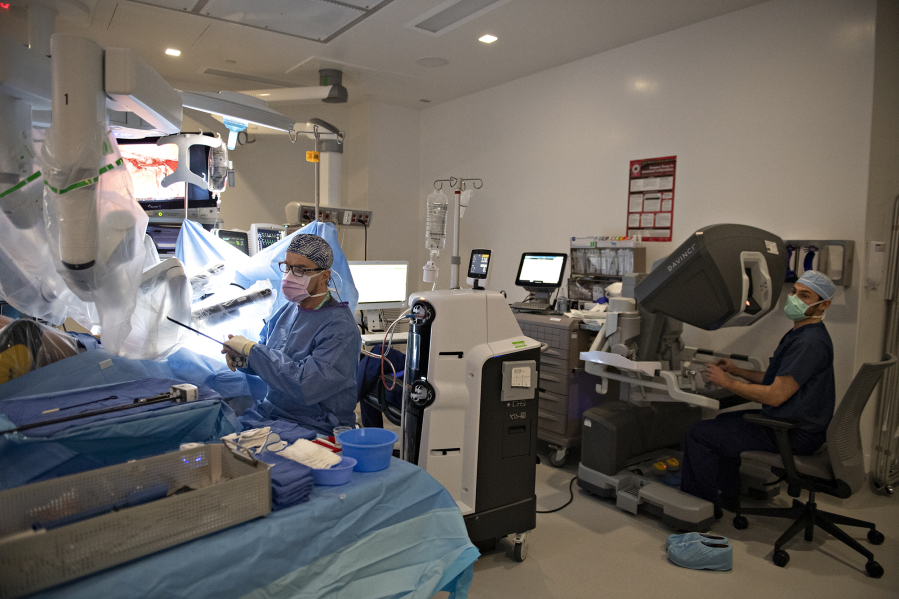Inside the new surgery center at Vancouver Clinic Salmon Creek, da Vinci has little to do with art. It’s a robotic surgical system used for minimally invasive outpatient procedures.
In November 2022, the Vancouver Clinic at 2525 N.E. 139th St. opened its doors to a new center called Salmon Creek 2, which encompasses urgent care, orthopedics and a surgery center. Included at that center is the da Vinci Robotic Surgical System. Vancouver Clinic is the first stand-alone outpatient surgical center in the region to use one.
The da Vinci allows surgeons to use smaller tools and access difficult areas of the body without a large incision. It can be used for gallbladder, hernia, reproductive organ, colon, kidney and bladder surgeries.
In March 2023, after Salmon Creek 2 opened, Dr. Jacob Calvert, OB-GYN; Dr. Leslie Disher; and surgical technologist and robotic coordinator Alanna Palmer started an outpatient hysterectomy program, hoping they would be able to provide wraparound services along with surgeries.
On a snowy Wednesday morning, Calvert — along with a team of nurses, an assistant surgeon and an anesthesiologist — completed a hysterectomy, or surgical removal of the uterus, on patient Tina Sixberry, 43. It was one of the hundreds of hysterectomies Calvert has performed using the da Vinci since its installation last year. He first started using the da Vinci in 2010 when he was completing his residency.
“Since we designed this program from the ground up, we were able to build a team approach to surgeries and hysterectomies in general,” Calvert said. “A lot of patients are grateful to be able to go home the same day and have a minimally invasive procedure. We’re just happy to be at the forefront of this.”
Calvert, who’s been an OB-GYN since 2012, said using da Vinci increases agility and decreases recovery time and scarring, compared with open and laparoscopic surgeries. A traditional laparoscopic surgery is performed by hand using medical instruments inside the body with a camera.
With robotic surgery, the surgeon operates the instruments from outside the patient’s body using a three-dimensional camera and viewing console. Recovery is usually dependent on the experience of the surgeon and complexity of the case.
According to its manufacturer, Intuitive Surgical, the system is named after Leonardo da Vinci, who drew what many consider to be the first concept of a robot. It costs about $2 million.
“If I had a family member needing a hysterectomy, I would recommend they travel to Vancouver for surgery given what we can now offer,” Calvert said. “One thing that’s great about the surgery center in general is how to do these surgeries efficiently, so patients can come in and really move through this process in a safe way.”
Vancouver Clinic also offers an additional robotic-assisted surgical system for outpatient procedures. In 2021, orthopedists began using the MAKO robotic-assisted surgery device for full joint replacements for low-risk individuals. It allows surgeons to accurately place new hip and knee joints for natural movement.
Inside the OR
In the operating room, a team of seven people worked on Sixberry during her operation. Once the patient was asleep, the team quickly worked to get her ready for the surgery. Music from the 1990s played quietly over the speakers, including Radiohead’s “Creep,” and there was a steady flow of communication between everyone on the team.
For the surgical team, this hysterectomy would be the first of four for the day.
Next to the patient, anesthesiologist Dr. Errol Hull completed the intubation, which creates an open airway through the mouth to administer the anesthesia. He also monitored Sixberry’s vitals throughout the procedure.
Nurses Jessica Harms and Shawn Higginbotham disinfected the patient, ensured that she was positioned correctly and provided tools for the surgeons throughout.
Once the preparation was done, the procedure began. But Calvert didn’t stand over Sixberry like a typical surgeon. Instead, the da Vinci was positioned above Sixberry, while Calvert operated from a couple feet away using the system’s control center. With his thumb and middle finger controlling the instruments, he carefully detached the uterus from the inside of the body, removing it along with the cervix and fallopian tubes. He used his feet to control the instruments for cauterization and cutting.
“If you imagine holding instruments where your fingers are opening up scissors, the robot is doing the same thing, but I’m controlling everything,” Calvert explained. “There was a learning curve at first with da Vinci, but by far, this is the best way I can do surgery since I’m so used to it now.”
With the help of Palmer and assistant surgeon Dr. William Herzig, OB-GYN, the procedure was completed in less than an hour. Sixberry was able to go home the same day and begin her recovery.
Open communication between everyone on the team is how these procedures remain so efficient, according to Palmer.
“You have to communicate,” Palmer said. “The biggest thing when working with any doctor is that you have to speak up about the concerns you have.”




